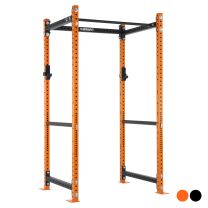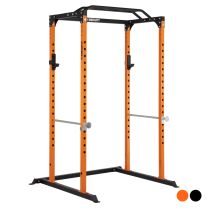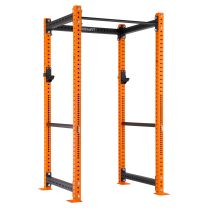How Much Room Do You Need For A Power Rack?
How Much Room Do You Need For A Power Rack?

Looking to build a garage gym? There are going to be some key factors that affect what equipment you decide to get.
Firstly, let’s consider what you want to get out of your home gym and why you might want to get a Power Rack in the first place.
Power Racks are the cornerstones of pretty much any workout area. Mainly because they’re so versatile. Not just for squats, you can do pull ups, bench presses and partial deadlifts in them – to name just a few – allowing you to cover all the main compound lifts with one piece of equipment.
The built-in safety bars are designed to catch the barbell should you fail which means you can train alone, safely.
Power cages can also help you to vary and progress your training with certain modifications such as resistance band pegs, dip bars and cable systems. And a lot of them can also be used to store your weight plates – ideal when you’re looking to save on floor space.
Finally, you can adjust the spotter and bar rest heights to exactly where you want them, allowing for correct posture and form.
And if strength training is something you want to do regularly, then it’s very likely you will need a power rack.
HOW BIG IS A POWER RACK?
Different power racks vary slightly in size, so we’re going to use our standard M1 250kg Power Rack as an example, to demonstrate the basic amount of space needed.
M1 250KG POWER RACK SPECIFICATIONS
• The M1 250kg Power Rack is 210cm in height which is just under 7ft.
• It has a width of 111cm and a depth of 113cm.
• The rack includes two adjustable safety bars, two adjustable bar rests and a pull up bar.
• There are 21 holes in each vertical frame piece so you can adjust appropriately for each user and exercise type.
• The M1 Power Rack weighs 56kg (without any added equipment) and has a maximum load capacity of 250kg.
• The frame is constructed from powder coated steel.
OTHER POINTS YOU SHOULD CONSIDER
As well as the size of the actual power rack, there are some other points you will need to factor in when choosing a power cage:
1 - FITTING IN YOUR WEIGHT BAR
As well as needing enough space for the power rack, you will also need enough room around the cage for your weight bar.
You can’t adjust the width of a power rack so the only bars that will fit safely across the width of the rack are:
The 6ft International Weight Bar is not to be confused with a 6ft Barbell. The international bar has the same centre length as the 7ft Barbell. This means the inside of the bar (in-between the sleeves) will rest securely on the bar rests at either end – allowing you to load your weight bar safely.
The reason it is only 6ft is because the sleeves are shorter than the ones on the 7ft bar. If you train with bumper plates, this is something you may want to factor in, to make sure you have enough room at each end for your weight plates.
Once you add your weight bar onto your power rack, you’ll need enough room not only for the weight bar but space around the bar to load, unload, rack and unrack, as well as move around the cage – depending on your set up.
Keep your barbells tidy in our Barbell Floor Stands.
2 - FITTING IN YOUR WEIGHT BENCH
The depth of the M1 Power Rack is 113cm. However, as well as factoring in enough room either side of the power cage, you will also need to factor in extra room at the front and back to make sure you have enough room for your weight bench.
And if you’re intending on doing bench presses within your rack, you will most likely need to position your bench slightly behind the back of the rack – depending on what Weight Bench you’re using.
This is also something to consider if you are planning on upgrading your power rack with a cable system. Doing this will add in an extra vertical bar down the back of the power cage which could mean you need to adjust the position of your weight bench.
3 - USING THE PULL UP BAR
Pull ups don’t generally require you to go much above the pull up bar. However, if you are planning on progressing to Muscle Ups, you will need to factor in extra room for you to go above the bar.
4 - EXTRA WEIGHT
Because of the weight and impact a power rack has on its surroundings, you will need to make sure your home gym is in a room that can handle the force. This means ensuring you build it in somewhere like the garage or basement.
If you’re unsure, we recommend you always seek the advice of a professional.
5 - UPGRADING YOUR GARAGE GYM
As you progress, it’s likely you will want to upgrade your home gym. This means always factoring in room for more equipment as you look for ways to optimise your training.
It might be that you need more weights as you get stronger, more bars or a wider variety of equipment as you save up and add more kit.
There are also ways you can upgrade the power rack. For example, you may want to add in weight storage bars, resistance bands or dip bars. For this, you will need to make sure you know the frame size of your power rack:
• M1 frames are 50mm x 50mm
• M2 frames are 60mm x 60mm
Resistance band pegs are particularly useful in helping you progress your strength training. Read more about the benefits of resistance bands here and how they can help you to increase your one-rep max.
You can read our ultimate guide to power racks here
For more content, follow us on Instagram, YouTube, TikTok, and on our official Mirafit Facebook page.
Enter your email to signup to our newsletter
Tags: Equipment > Power Racks and Cages ; Exercise Type > Strength ; Misc > Gym Planning







